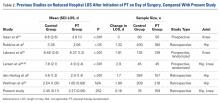Our finding of no statistically significant reduction in mean LOS after implementation of accelerated PT for THA or TKA differs from findings in multiple other reports.4,5,13-17 Baseline or control group mean LOS tended to be higher in previous studies3,5,18-23 (3.4-11.4 days) than in our control group (2.5 days) (Table 2).
Although we did not find a statistically significant reduction, a higher percentage of THA Day 0 patients were discharged on POD-1, potentially justifying use of accelerated PT for these patients. Another study reported a similar percentage of patients discharged on POD-1 after accelerated rehabilitation.3 In addition, total number of PT sessions per patient did not differ between groups, limiting the cost-effectiveness of accelerated PT—in contrast to previous reports showing a cost benefit to accelerated PT after THA.21 Achieving a meaningful change in LOS after THA and TKA needs to be weighed against potentially compromising patients’ safety, outcomes, and satisfaction. We think use of accelerated PT after THA can facilitate achieving PT goals expeditiously and enhance early postoperative function. Achieving PT goals by POD-1 can help restore patient confidence and allow surgeons to sign off on early but safe discharges. Although accelerated PT may provide some benefit (eg, patient satisfaction, confidence) for TKA patients, there was no demonstrable decrease in the important metric of LOS. PT goals may serve as an alternative to LOS alone in determining the effectiveness of accelerated PT. More objective PT parameters (eg, muscle strength testing) may add more validity to this argument, but we did not use them in this study. The retrospective design of this study is considered a weakness, but we should point out that hospital and surgical protocols were applied uniformly to all patients. Furthermore, we expected longer LOS for our Non-Day 0 patients because we thought they would be less willing to have Day 0 PT. To our surprise, LOS did not differ between the Day 0 and Non-Day 0 groups in both THA and TKA. However, it is important to note that more THA Day 0 patients were discharged on POD-1 (P = .04). The strengths of this study include its simplicity, adequate statistical power, and lack of a difference in patient demographics between groups. In summary, day-of-surgery PT did not change LOS after elective primary THA or TKA. For elective THA, however, same-day PT helped in achieving POD-1 discharge goals.Conclusion
These results provide useful information for providers who are managing primary THA and TKA cases and seeking continual improvement in postoperative patient care and better resource allocation. Hospitals, particularly those operating in bundled-care environments, are increasingly coming under scrutiny to control costs. Our study results showed that the costs associated with Day 0 PT are justified for THA but not for TKA.
Am J Orthop. 2016;45(6):E337-E342. Copyright Frontline Medical Communications Inc. 2016. All rights reserved.

